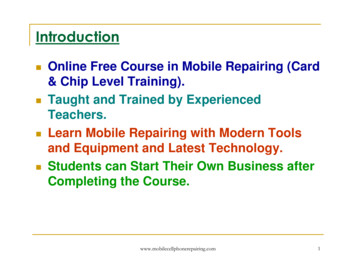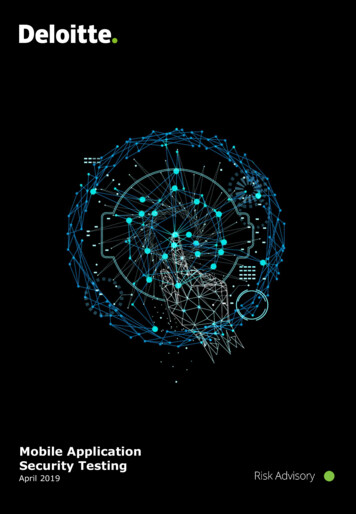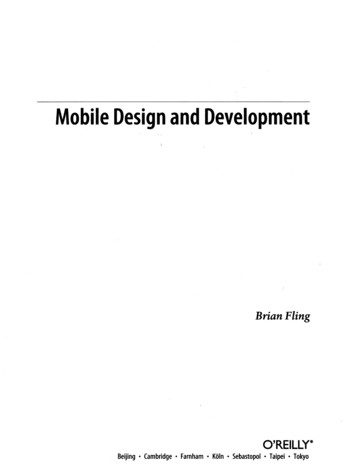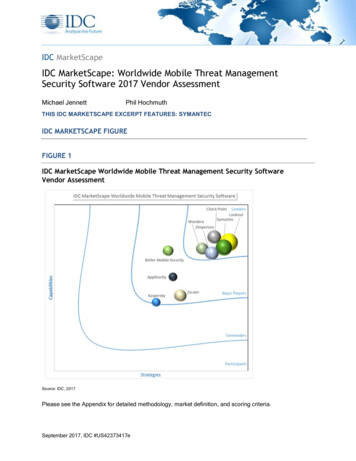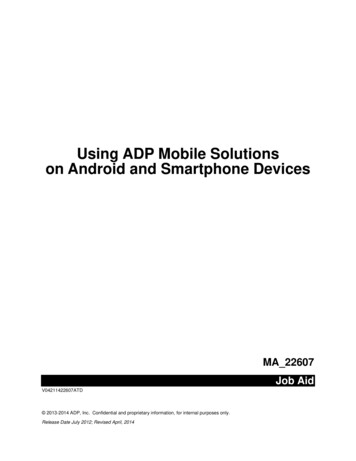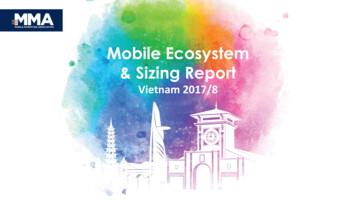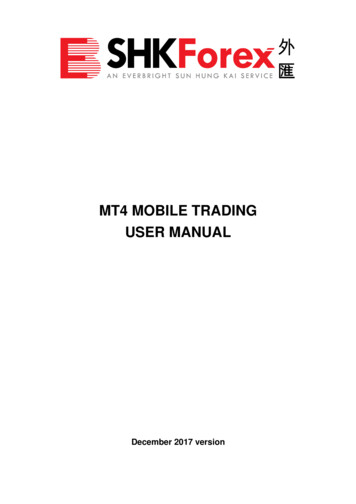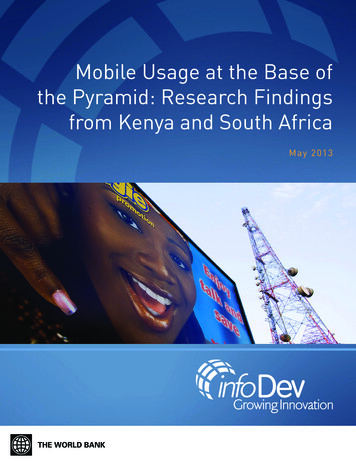
Transcription
Mobile Usage at the Base ofthe Pyramid: Research Findingsfrom Kenya and South AfricaMay 2013
MOBILE USAGE AT THEBASE OF THE PYRAMID:RESEARCH FINDINGS FROMKENYA AND SOUTH AFRICAMay 20132
The report “Mobile Usage at the Base of the Pyramid: Research Findings from Kenya and South Africa” is available athttp://www.infodev.org/mbopsummary.For the full Kenya report, please visit www.infodev.org/en/publication.1194.html.For the full South Africa report, please visit www.infodev.org/en/publication.1193.html. 2013 International Bank for Reconstruction and Development / The World Bank1818 H Street NW, Washington DC 20433Telephone: 202-473-1000; Internet: www.worldbank.orgSome rights reservedThis work is a product of the staff of The World Bank with external contributions. Note that The World Bank does notnecessarily own each component of the content included in the work. The World Bank therefore does not warrant that the useof the content contained in the work will not infringe on the rights of third parties. The risk of claims resulting from suchinfringement rests solely with you.The findings, interpretations, and conclusions expressed in this work do not necessarily reflect the views of The World Bank,its Board of Executive Directors, or the governments they represent. The World Bank does not guarantee the accuracy of thedata included in this work. The boundaries, colors, denominations, and other information shown on any map in this work donot imply any judgment on the part of The World Bank concerning the legal status of any territory or the endorsement oracceptance of such boundaries.Nothing herein shall constitute or be considered to be a limitation upon or waiver of the privileges and immunities of TheWorld Bank, all of which are specifically reserved.Rights and PermissionsThis work is available under the Creative Commons Attribution 3.0 Unported license (CC BY 3.0)http://creativecommons.org/licenses/by/3.0. Under the Creative Commons Attribution license, you are free to copy,distribute, transmit, and adapt this work, including for commercial purposes, under the following conditions:Attribution—Please cite the work as follows: infoDev (2013). Mobile Usage at the Base of the Pyramid: Research Findingsfrom Kenya and South Africa. Washington, D.C: World Bank. Available at: http://www.infodev.org/mbopsummary.License: Creative Commons Attribution CC BY 3.0Translations—If you create a translation of this work, please add the following disclaimer along with the attribution.This translation was not created by The World Bank and should not be considered an official World Bank translation.The World Bank shall not be liable for any content or error in this translation.All queries on rights and licenses should be addressed to the Office of the Publisher, The World Bank, 1818 H StreetNW, Washington, DC 20433, USA; fax: 202-522-2625; e-mail: pubrights@worldbank.org.Cover photograph: 2006 Arne Hoel/The World BankCover design: infoDev3
ABOUT INFODEVinfoDev is a global partnership program within the World Bank Group which works at the intersection of innovation,technology, and entrepreneurship to create opportunities for inclusive growth, job creation and poverty reduction. infoDevassists governments and technology-focused small and medium sized enterprises (SMEs) to grow jobs, improve capacity andskills, increase access to finance and markets, ensure the appropriate enabling policy and regulatory environment for businessto flourish, and test out innovative solutions in developing country markets. We do this in partnership with other developmentprograms, with World Bank/IFC colleagues, and with stakeholders from the public, private and civil society sectors in thedeveloping world.For more information visit www.infoDev.org or send an email to infoDev@worldbank.org.4
ACKNOWLEDGEMENTSThis summary report was commissioned by infoDev, a global partnership program within the World Bank, and drafted byKevin Donovan. It is based on case studies of Kenya (conducted by iHub Research and Research Solutions Africa) and SouthAfrica (conducted by Research ICT Africa and Intelecon). It is part of a broader research project looking at how the poorestof the world’s citizens use mobile phones to enhance their lifestyles and livelihoods. The task team leader on behalf ofinfoDev is Tim Kelly and the task team manager is Maja Andjelkovic. The task team would like to thank external reviewers,including Ilari Lindy (World Bank Institute), Angela Bekkers, Toni Eliasz and Nicolas Friederici (infoDev), Monica KerrettsMakau (Communications Commission of Kenya), Rohan Samarajiva (LIRNEasia), Marta Milkowska (PREM), CeciliaParadi-Guilford (TWICT), and Juhee Kang (MSU). The original work of the case study authors is also acknowledged,including Enrico Calandro, Alison Gillwald, Mariama Deen-Swarray, and Christoph Stork (Research ICT Africa), SteveEsselaar (Intelecon), Angela Crandall, Albert Otieno, Leonida Mutuku and Jessica Colaço (iHub Research), and JasperGrosskurth and Peter Otieno (Research Solutions Africa).The report was made possible by the support of the Ministry for Foreign Affairs of the Government of Finland and UKaid.For further information contact:infoDev / World Bank1818 H Street NWWashington, DC 20433United Stateswww.infodev.orginfo@infodev.org5
TABLE OF CONTENTSIntroductionMobile Communication in Developing CountriesThe Fortune at the Base of the Pyramid? From Consumption to ProductionI. Mobile Insights from the Base of the Pyramida. The Evolving Mobile Entrepreneurship Ecosystemb. The Social Context of Usec. Jobs and Job Creationd. Innovation Business Strategies for the Base of the Pyramide. Regulatory Issues, Old and New889111112121415II. Kenyan Mobile Usage at the Base of the Pyramida. Introductionb. Methodologyc. Mobile Access and Use at the Base of the PyramidAccessUsaged. Mobile Moneye. The Entrepreneurial Ecosystemf. Policy Discussiong. Conclusion17171818182021212323III. South African Mobile Usage at the Base of the Pyramida. Introductionb. Methodologyc. Mobile Access and Use at the Base of the Pyramidd. Mxite. The Entrepreneurial Ecosystemf. Policy Discussiong. Conclusion2424242426272828IV. Conclusion296
LIST OF FIGURES, TABLES AND BOXESFIGURESFigure 1. Effects of pricing on mobile applications usage in UgandaFigure 2. Research LocationsFigure 3. Reasons for not having a phoneFigure 4. Operator Market SharesFigure 5. Elements of the Mobile Ecosystem1418192427TABLESTable 1. Kenya & South Africa at a GlanceTable 2. Reasons of non-users for not using the Internet1625BOXESBox 1. Defining 'the Base of the Pyramid'Box 2. Mobile Innovation at the World BankBox 3. Building Entrepreneurial Ecosystems: AkiraChixBox 4. Public? Private? Both? Neither? The Indeterminacy of Share UsageBox 5. Frequent Obstacles for Large Corporations at the BoPBox 6. Sacrificing for Mobile ConnectivityBox 7. Powering Mobile at the BoP9101112142122All dollar amounts are U.S. dollars unless otherwise indicated.7
IntroductionThe phenomenal growth of mobile communicationsin developing countries over the past ten years hasbeen widely celebrated. There were more than 6.8billion connections by the end of 2012, representing3.2 billion subscribers. More than 650 millionconnections were in Africa alone. Networks acrossthe world are being upgraded to higher speeds andcapacities, and devices, too, are becoming moresophisticated. As such, calls and SMS areincreasingly being augmented by more advancedapps and services.At a general level, the contours of this success arewell known: from nearly absent at the turn of thecentury, mobile phones have spread widely acrossthe developing world, now sitting in the pockets ofthe most poor and remote individuals; more recently,calls and SMS have begun to be complemented bymore sophisticated applications and services, fromfinancial products to government services. A varietyof causes for this shift are well documented:privatization and liberalization created an enablingenvironment, technological advances brought downthe cost of connectivity, business model innovationsmade them accessible to the base of the pyramid,and the inventive communication strategies of usersopened new doors.Less well understood, however, are the particularand diverse ways in which mobile connectivity isbeing used in everyday life, from Kinshasa toKibera. Technology is eminently social, bound up inthe local context and culture, so broadgeneralizations about its global character are boundto overlook important differences in the meaningand significance of mobile telephony in thedeveloping world.This knowledge gap has real world implications.From improving literacy to creating jobs,governments, NGOs and businesses across the worldare seeking to use mobile phones and applications tomeet human and economic development goals.However, many of these innovations have beenstymied, not least because they have not provenacceptable or desirable to the locality into whichthey are introduced. Technical know-how andentrepreneurial acumen must be complemented bysociocultural understanding.infoDev’s Mobile Use at the Base of the Pyramid(m@BoP) program seeks to contribute to thisagenda through on-the-ground studies in developingmarkets. The first phase of this program supportedboth qualitative and quantitative research on mobileusage by low-income populations in Kenya andSouth Africa. These locations were chosen for avariety of reasons. Both economies display regionaland continental clout. The growth of their ICTsectors has been marked by both successes andshortcomings in the past ten years. And both arehome to emerging communities of softwaredevelopers, many of whom are associated with theMobile Innovation Labs (mLabs) that infoDev andpartners have supported to help incubate anentrepreneurial ecosystem. While Kenya and SouthAfrica are not representative of the continent as awhole, they are among the most exciting given theconfluence of technical talent, financial resources,and generalized y now, the surge in access to mobile connectivityis no secret: across the world, regulatory reforms,business model innovation and technologicaladvances have served to widely broaden theaccessibility of mobile phones, for both basicdevices and, increasingly, more sophisticated smartphones and tablets. Developing countries are alsoyoung and growing wealthier, further driving access(World Bank 2012a). In Kenya and South Africa, thepercentage of mobile phone subscribers have risenfour or five fold in the past ten years.8
Box 1. Defining 'the Base of the US 1,500or 2,000(atPPP),butothershavedroppedaslowas 1- fUS oundUS revealedfewdifferences).While voice and SMS still remains the dominantuses of mobile phones, the reality is hardly static.Voice growth has slowed as data and ography 2012). The 5 trillion SMS that weresent globally in 2010 –accounting for 80 percent ofoperator value-added service revenue (VAS) –arequickly being challenged by third-party messagingservices such as BlackBerry Messenger orWhatsApp. So too is traditional calling being rivaledby Voice over IP (VoIP), especially in areas whereWiFi is availalble. And a host of new services andapplications and more tailored services providingagricultural or health information.LIRNEasia, a South Asian think tank, deemed theseemerging uses ‘Mobile 2.0.’ Although basicconnectivity still remains an issue for many –especially the poorest – there is a growing consensusthat shifting attention toward application andservices will increase the developmental dividendsof mobile communications. Their work exploredMobile 2.0 in sectors as diverse as agriculture,public transportation, and health services,demonstrating both the promise and the necessaryapproaches to unleashing successes like Mxit andM-PESA have been in ptiontoProductionThe approach taken in this report is grounded in abelief that the private sector has much to offer to theprocess of development, particularly in situations ofconstrained public sector capacity. This case wasmade most prominently by C.K. Prahalad in his1See LIRNEasia’s work on the topic e20bop/2004 book The Fortune at the Bottom of thePyramid, and has since spurred a wide communityof proponents, as well as a share of detractors.Prahalad and colleagues have proposed that ations, have the potential to deliverdevelopmentally beneficial services, such as cleanwater, healthcare and financial services. Given thedifficulties associated with traditional aid or publicservices, a market-based approach is seen to be moreefficient, sustainable and inclusive. To do so,however, requires significant innovation andadaptationtotherealities of developing countries, and much efforthas been expended on detailing these means.Information and communication technology has aprivileged spot within this literature. While manysectors have stumbled, by and large the mobileindustry has been able to successfully reach the baseof the pyramid. While the technical attributes arenecessary, they are only sufficient due toorganizationalingenuity.Forexample,GrameenPhone in Bangladesh pioneered communaltelephony and paired it with access to finance. Evenprepaid airtime – now taken for granted – wasnecessary given the lower purchasing power andlack of credit history at the base of the pyramid.However, it would be a mistake to uncriticallyaccept the success of mobile communication at thebase of the pyramid as proof of the premise moregenerally. As Aneel Karnani (2009) has argued, theBoP market is oftentimes small, heterogeneous anddifficult to serve profitably due to geography, poorinfrastructure and high transaction costs. Moreabstractly, solely focusing on the role of the privatesector in poverty alleviation risks ignoring the9
important role for the state and civil society. Here,too, telecommunications are indicative: whileliberalization and competition have been necessaryto improve access to mobile communication, as thecases of Kenya and South Africa demonstrate, thesustained commitment of a regulator is a necessarycomponent to promoting the vibrancy of the ICTsector. Amongst others, managing competition,promoting universal access, and protectingconsumers remains an important and ongoing task.In addition, there are a variety of ways to ensure thepromised fortune at the bottom of the pyramid isbeneficially realized. The main contribution of thisreport is to improve our collective understanding ofhow mobile phones and services are used by lowincome populations in Kenya and South Africa.While the project included a specific considerationof the private sector, the insights should also beapplicable to governments, non-profits and civilsociety. With regard to the private sector, this reportfinds more promise in production, rather thanconsumption. That is, while much of the base of thepyramid literature focuses on the benefits toconsumers of new offerings, this report is aimed atimproving the prospects for job and enterprisecreation. These are not mutually exclusive, but giventhe ongoing importance of employment (WorldBank 2013), finding ways to leverage the mobileplatform for job creation is a pressing and promisingtask. As such, there is a particular focus on thestrategies and methods through which enterprisesand jobs may be created in the mobile sector.The remainder of this report is divided into foursections. Chapter 1 provides an overview of thefindings from the Kenyan and South African casestudies, focusing on the cross-cutting themes thatemerge from that research and the base of thepyramid literature. Chapters 2 and 3 providerespective summaries of the Kenyan and SouthAfrican studies, explaining in more depth themethodologies, general usage and impact findings,and discussions of the entrepreneurial ecosystem andpolicy implications. Finally, a brief conclusionoffers a summary and suggested next steps.We hope this work is useful for two primaryaudiences. For policymakers and developmentprofessionals, we hope the evidence about theimportance of social context informs projectplanning and assessment. And for the networks ofentrepreneurs working in the mobile sector, we hopethe details on usage contained in the full reports arehelpful in creating productive businesses.Box 2. Mobile Innovation at the World owledge- orld.10
I.MobileInsightsfromtheBaseofthePyramidWithin the literature on mobile communication indeveloping countries, the canonical studies haveoften emphasized the economic impact oftechnology’s diffusion. However, the process ofdiffusion is a highly complex one of interactionbetween communities and devices, often withchanges occurring on both sides. Successfulinnovation requires a robust understanding of thespecific context and a commitment to ongoingadaptation. This type of knowledge is most likely tocome from sustained, on-the-ground engagement,rather than the synoptic knowledge of limitedexposure. Drawing on both the wider literature andthe infoDev m@BoP studies in Kenya (see linkbelow) and South Africa, this section details avariety of usage insights as well as cross-cuttingthemes about the use of mobile phones and servicesat the base of the pyramid. In particular, it discusses: The evolving ecosystem for mobileentrepreneurship,The importance of understanding the socialcontext of mobile use,The evidence of impact on job creation,Strategies for innovation at the base of thepyramid, andThe ongoing importance of appropriateregulation.Kenya ml)South Africa ml)a.TheEvolvingMobileEntrepreneurshipEcosystemThe mobile application industry is characterized bydiverse set of stakeholders and a high degree , and content providers. Thisfragmentation presents considerable opportunitiesfor innovators, but also results in a complexenvironment with different technological standardsand business models. For example, applications rs, or third-parties. They can be writtenfor low-end phones and rely on SMS, target midrange devices using Java or PHP, or make use ofsophisticated features on smart phones. Thiscomplexity requires new models of communicationand collaboration, as well as developers who have ahigh degree of skill and the ability to rapidly learn(World Bank 2012a: chapter 5). This creates newopportunities for entrepreneurs (see Box I).This disruptive era has resulted in challenges toexisting stakeholders. Before the rise of the smartphone, mobile network operators were the keygatekeeper to application developers, and forcultural, financial, and technological reasons, theywere not disposed to encouraging third-partyinnovation. For example, being issued an SMS orUSSD shortcode could be difficult or evenimpossible. Smart phones have changed this to someextent: the availability of sophisticated mobileplatforms, and the success of the iPhone App Store,has convinced developers around the world thatthere is a strong business case for developing mobileapplications. While smart phones are still not asaccessible in the developing world, as they grow, thegatekeeper role of mobile network operators willdecrease in some cases. In their place, new mobileplatforms often actively encourage developersthrough permissive licensing and financialincentives. Of course, this does not herald the end ofgatekeepers – platforms like Apple iOS and GoogleAndroid still have ultimate say in what is allowed –but it is a significant change from just five years ago.The studies in both Kenya and South Africa foundthis structural change to be a key motivator for manydevelopers.Box 3. Building Entrepreneurial Ecosystems: gcommunitiesofknowledge- rsinNairobi.AkiraChixhostsget- rgingtechnologyscene.Source:Warner,G.(2012).
b.TheSocialContextofUseThe genesis of the m@BoP research program was abelief that the social context of mobile use plays aconstitutive role in the adoption and use of ICT. Forentrepreneurs, governments and NGOs seeking tomake the most of mobile connectivity,understanding and constantly adapting to the localcontext is essential. For example, M-PESA has beenwidely adopted as a mobile financial service in largepart because it is significantly less expensive thanthe alternative methods. But as Kuriyan et al. (2012)argue, to only view M-PESA through the lens ofcost would be to miss an important aspect of itssuccess: Safaricom was a well-trusted brand andtook great effort to ensure that trust remainedthrough monitoring its agents closely. Furthermore,M-PESA was not marketed as a service for the baseof the pyramid. Instead, it was exactly because MPESA was aspirational, and not tied to the stigma ofpoverty, that it became widely used within the baseof the pyramid.There is a danger that the term ‘base of the pyramid’suggests a unified, homogeneous population; inreality, the lowest income brackets in any countryare highly diverse in their geography, culture,language and more. These preexisting variables – thecontext within the base of the pyramid – will serveto influence the use of mobile communications, aswell. To take an example from China, Wallis (2011)has documented how the pre-existing status ofwomen guides the impact of mobile connectivity:autonomous micro-entrepreneurs report being ableto improve their productivity through adoptingphones, while, in other settings, the phone became atool of increased surveillance on already vulnerableemployees. Indeed, similar findings emerged inthese studies. In South Africa, more well-to-doindividuals report better outcomes from havingaccess to a phone because they have the existing ofresources and networks to leverage connectivity. InKenya, gender – including for services like M-PESA– is not statistically significant as a differentiator ofphone ownership and usage, but it generallyreflected indirectly through income and educationaldifferences.Box 4. Public? Private? Both? Neither? TheIndeterminacy of Shared areoftenmoreexpensiveonaper- ingothersuptoFacebook;inKenya,M- ndJobCreationAs discussed at length in the World Bank’s (2012a)recent publication Information & Communicationfor Development: Maximizing Mobile, the mobileindustry is now a major source of employmentthroughout the world, through both direct andindirect jobs. The ITU estimates that direct jobs –from mobile network operators and manufacturers –are around 1.5 million people worldwide (ITU2011). When including indirect jobs – such as thosein application development, content creation, andcall centers – the figure is significantly larger: oneestimate for India alone expected 7 million indirectmobile jobs during 2012 (COAI 2011). Althoughthese figures are difficult to calculate, it seems clearthat as mobile usage grows, its share of employmentwill, as well. In particular, three types of impactseem promising.12
Mobile phones offer an opportunity to increase labormarket efficiency through job search applications.Emerging models of ‘microwork’ – where incomegenerating tasks are accessed through mobiledevices – offer new modes of employment. And thegeneration of new enterprises through content andapplication development can create vibrantentrepreneurial communities in new places.JobSearchCoordinating employment in many countries can bedifficult, not the least because qualified applicantsand hiring firms are disconnected. In manydeveloping countries, the poor are subject to localmonopolies, but widening their search capacity canhelp to ease that burden. In a variety of markets,efforts have been taken to improve upon traditionaljob search methods through adopting the mobileplatform. Applications like Babajob (India), AssuredLabor (Latin America), and Souktel (Middle Eastand North Africa) create a unified source for jobsearchers to find who is hiring (see Selim 2012).Unlike web-based services, these are not alwayssufficient for hosting a full résumé, but that canprovide necessary information to the labor market.In doing so, they help reduce the time and cost ofemployment for job seekers and hirers. For example,in South Africa, Ummeli is an application operatedthrough Vodacom that provides learning and skilldevelopment opportunities and currently has 88,000users after a year of operation.published a strategy in 2009 to invest in creating100,000 jobs in the sector, though it currently is lessthan half of that. A Monitor (2011) report estimatedthat the impact sourcing market generated US 4.5billion in revenues and was set to grow as traditionalBPO markets like India became more costly.While generally based currently in a single officeusing PCs, as mobile phones increase insophistication, this market could very well becomedistributed out of offices.Already, a firm named Jana (previously, TxtEagle)is using mobile money applications like M-PESA topay Kenyans for doing basic tasks of larger projectsfor multinational corporations. While the workloadfluctuates and is not sufficient to be a full-time job,it offers income opportunities for underemployedindividuals in a way that is widely accessible.Impact sourcing, and microwork more specifically,requires acquiring both literate laborers and anchordemand, as well as ensuring the quality of work tosustain the business. According to Monitor,promising paths are partnering with more establishedBPO firms (such as through serving as their backoffice) and boosting demand through governmenttasks (such as digitization). It is worth bearing inmind, though, the resistance to this idea as a form ofprecarious labor.MicroworkAnother way that mobile phones serve to improveemployment in developing countries is throughfacilitating microwork, or task-based incomegeneration. For example, mobile users can receiveremuneration for translating text or identifyingimages for search engines. Although this market isnon-traditional and often part-time, a previousinfoDev study suggested that microwork alreadyemploys 100,000 people and contributes to a globalvirtual economy valued at US 3 billion per year(infoDev 2011).EnterpriseCreationAs mentioned above, the mobile industry generatessignificant employment globally through core firmssuch as mobile network operators and hardwaremanufacturers, as well as the supporting ecosystemof airtime retailers, mobile money agents, andrepairmen. Increasingly, however, the growth ofmobile applications means that a new form ofindirect employment is rising: the mobileentrepreneur. The technical barriers to entry forindividual developers and small to medium sizedenterprises is reducing significantly. Oftentimes,these developers can compete globally due to lowerwages.Microwork is closely related to so-called “impactsourcing,” the use of business process outsourcing(BPO) to positively improve low-incomelivelihoods. Firms like Samasource, Paradigm andDigital Divide Data are active in Kenya, and theSouth African Department of Trade & IndustryPrivate industry, go
I. Mobile Insights from the Base of the Pyramid 11 a. The Evolving Mobile Entrepreneurship Ecosystem 11 b. The Social Context of Use 12 c. Jobs and Job Creation 12 d. Innovation Business Strategies for the Base of the Pyramid 14 e. Regulatory Issues, Old and New 15 II. Kenyan Mobile Usage at the Base of the Pyramid 17 a. Introduction 17 b.



